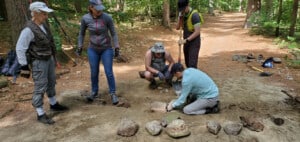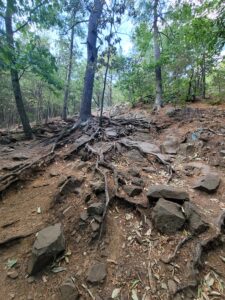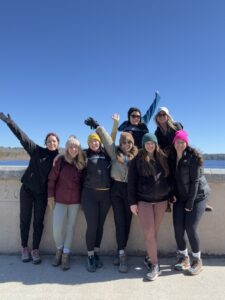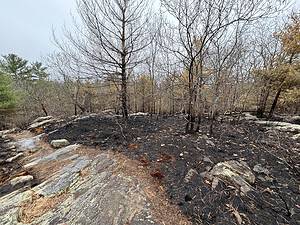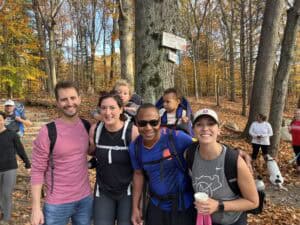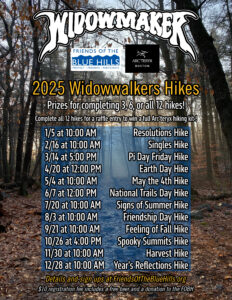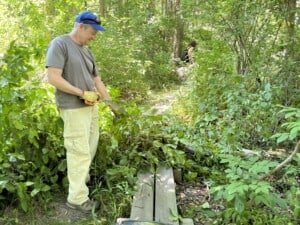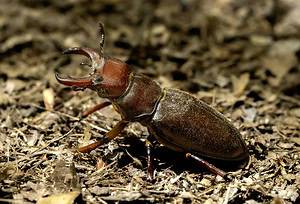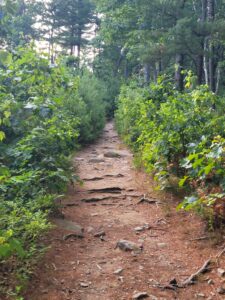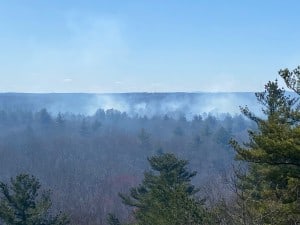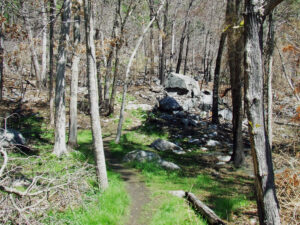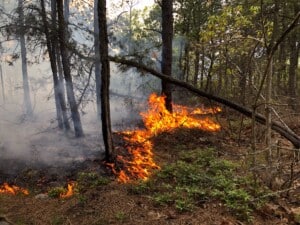Want to make a big difference to our parks?
Sometimes the best thing to do for our parks is to make no difference at all!
When you “Leave No Trace,” you’ll help protect all of our conservation lands.
Why should we ‘Leave No Trace”? Simply put, we are all responsible for caring for the Blue Hills and that means protecting over 7,000 acres of land. We are all visitors to the area and must leave as little impact on the land as possible. This shared responsibility rests on the shoulders of all recreation users, young and old. If we practice “Leave No Trace”, then the Blue Hills will stay buzzing with natural life and remain accessible for many years, protecting many species.
Help us “Leave No Trace” and become a Friends of the Blue Hills Member!
How can I “Leave No Trace”? There are many things you can do to make sure that you leave as small a footprint as possible in the Blue Hills or on other natural trails. Being mindful of your presence is the first step. Here is a list of some important “Leave No Trace” principles that can help guide your visit to ensure that these conservation lands remain preserved for generations to come.
- Plan ahead. Preparing for your hike makes it less likely that you will violate any of the other principles of “Leave No Trace”. Be prepared for extreme weather, carry a map, and know the rules and regulations of the Blue Hills. Being prepared can help you avoid extreme fatigue and keep your decision making sharp.
- Travel only on the marked trails. Erosion from activity off marked trails can damage wooded and rocky areas beyond normal use. Often times there are sensitive plant or animal and insect species that rely on a quiet, calm environment and those species flourish off the trails. These sensitive species might die out with a single stamp from an off-trail hiker.

Photo: Kyle Doan (Randolph) “Perfect View of the Pond”
- Carry out all trash and waste. As humans, we carry in a lot of materials that are not natural to the Blue Hills—clothing, paper products, trash, and even poop. When we enter the trail system, make sure to keep close control over any trash and avoid accidentally dropping anything. Bring a bag for trash to carry it out. If you are hiking with a dog, please pick up your dog’s poop and carry it to a trash receptacle for proper removal. If you see any other trash along the trails that may have been accidentally dropped by others, do a good deed and pick it up and carry it out yourself! We must all work together as a team to maintain our trails. Pack it in, pack it out.
- Respect wildlife. The Blue Hills are home to many different animals! There are turtles, toads, owls, deer, snakes, and so much more! These animals have made the Blue Hills their home and good “Leave No Trace” practice is to keep your distance. Please respect the wildlife and let animals pass in peace. Do not feed them, touch their habitats or nests, or disrupt their lives. If you want to observe some of the wildlife in the Blue Hills, recommend checking out the Trailside Museum.

Photo courtesy of Patrick Randall of Lancaster.
- Make sure your campfires are regulated. If you are camping in the AMC cabins at Ponkapoag, you are permitted to have a regulated campfire. Some of those cabins have outdoor grills and others have fire rings. Fires are only permitted if you are camping with reservations at AMC. Try to keep the campfire small—larger fires can quickly get out of control. When done, make sure all wood is burned to an ash, put out the fire completely, and then spread the hot ashes out to cool. Be sure to use firewood from the same area where you are camping, bringing in firewood from other areas can introduce invasive species that can cause destruction. Lastly, if you are unsure about how to properly start, manage, and extinguish a fire—bring a camp stove as an alternative for your cooking needs.
- Leave nature in nature. Those rocks may look cool, but let’s leave them in the woods. You might think that taking a rock or a souvenir home from your hike is relatively harmless, but if every visitor were to take something home, we would be left without much left! It’s great practice to teach kids the values of “Leave No Trace” on your hikes by telling them why we want to leave nature alone, and leave those rocks in the woods. As humans, we are only visitors to the land and should treat our experience as such.
- Be considerate of other visitors. We share the Blue Hills with many different types of recreational users—including hikers, mountain bikers, runners, horses, and visitors of all ages. Be courteous and considerate of each other as well as the land. Keep human noise to a minimum, control all dogs, teach children to respect others on the trail.
While not part of “Leave No Trace” practice, another way to preserve the Blue Hills is through advocacy and working to prevent inappropriate development — and becoming a Friends of the Blue Hills member! Building on the land will eliminate delicate species and impact the ecosystem for the entire land space. There are plenty of ways to help advocate for the Blue Hills! You can:
- Contact local representatives to remind them how important the Blue Hills are.
- Volunteer with Friends of the Blue Hills to maintain the trails
- Become a member of the Friends of the Blue Hills! As a member, you protect the Blue Hills’ wildlife – and make sure visitors can enjoy the park for generations to come!
Top photo credit: Kristen Gabriele (Canton) “Through the Trees”



